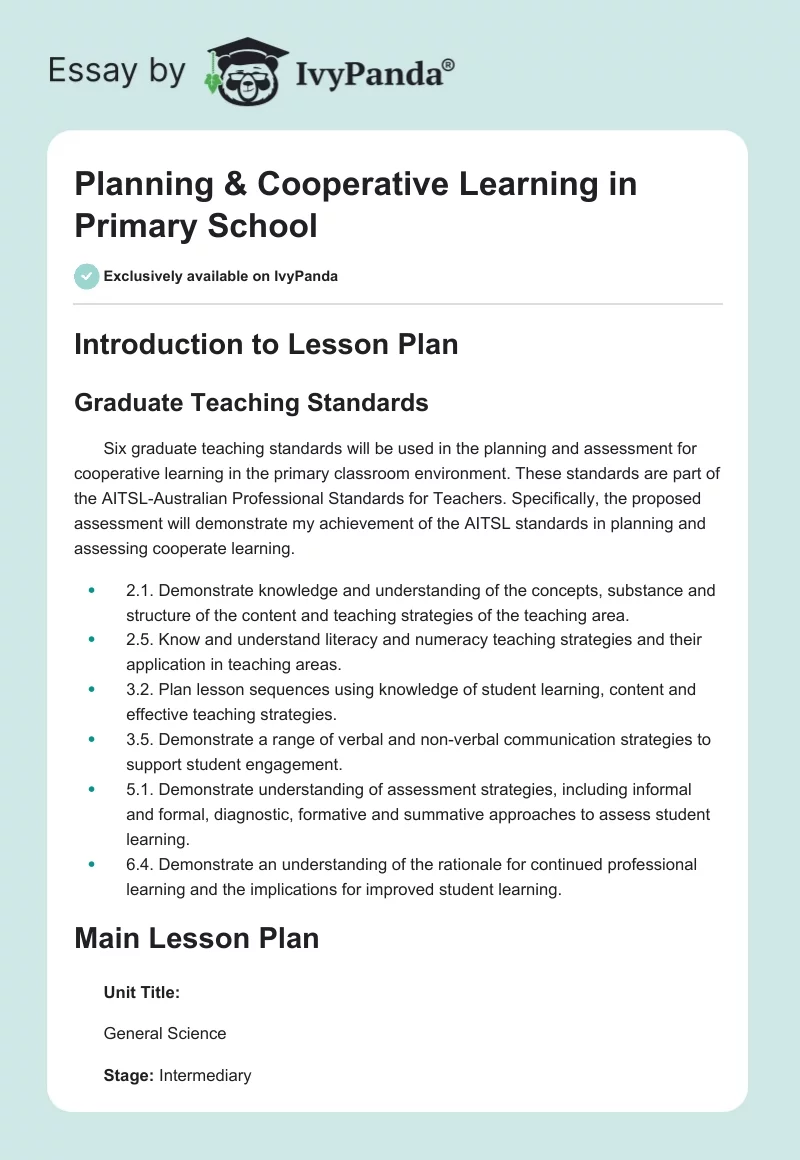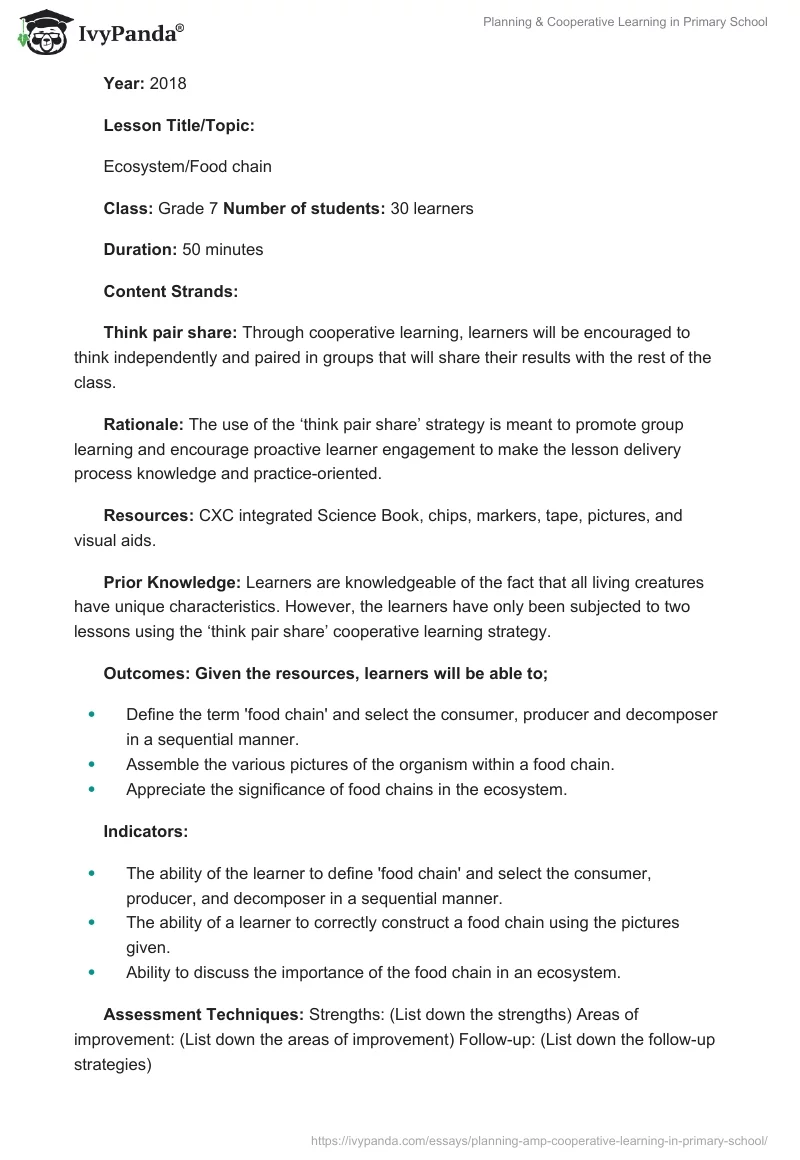Introduction to Lesson Plan
Graduate Teaching Standards
Six graduate teaching standards will be used in the planning and assessment for cooperative learning in the primary classroom environment. These standards are part of the AITSL-Australian Professional Standards for Teachers. Specifically, the proposed assessment will demonstrate my achievement of the AITSL standards in planning and assessing cooperate learning.
- 2.1. Demonstrate knowledge and understanding of the concepts, substance and structure of the content and teaching strategies of the teaching area.
- 2.5. Know and understand literacy and numeracy teaching strategies and their application in teaching areas.
- 3.2. Plan lesson sequences using knowledge of student learning, content and effective teaching strategies.
- 3.5. Demonstrate a range of verbal and non-verbal communication strategies to support student engagement.
- 5.1. Demonstrate understanding of assessment strategies, including informal and formal, diagnostic, formative and summative approaches to assess student learning.
- 6.4. Demonstrate an understanding of the rationale for continued professional learning and the implications for improved student learning.
Main Lesson Plan
Reflection
What I Did
The use of the ‘think pair share’ as a cooperative learning strategy was an interesting scheme in developing the above lesson plan. I commenced the creation of the lesson plan by selecting the appropriate intermediate learning level. The most challenging part was the selection of the appropriate topic that can be delivered through cooperative learning. I eventually selected the topic called the ‘Food Chain’. In order to demonstrate the rationale for continued learning, as indicated in AITSL standard 6.4, I proceeded to develop relevant teaching and learning strategies to incorporate the element of learner participation (Carolina, 2012).
I opted for a learner-guided teaching strategy to ensure that the students are at the forefront to enhance individual accountability in line with the AITSL standard 3.5. I managed to create a strategy for demonstrating verbal and non-verbal strategies to promote proactive learner engagement (Gillies & Boyle, 2013). The entire lesson was created around encouraging and demonstrating the aspect of teamwork through group processing and positive interdependence, as is the case with the animals and plants (Kivunja, 2015).
For instance, the selection of the food chain topic was symbolic of making the demonstration of the actual assessment as a systematic and formative process in line with the AITSL standard 5.1 (Alenka, 2015). Actually, the topic content was modified to include the summative and formative learner assessment. For example, the lesson has a provision for assessing the ability to correctly identify, classify, and construct a food chain to promote equal participation (Kivunja, 2015). I created the assessment procedure to demonstrate the direct understanding and knowledge of the food chain. I structured its content to include proper identification of different parts of the chain through an interactive method as captured in AITSL 2.1 (Australian Institute of Teaching and School Leadership, 2011).
What I Learned
The lesson plan was created to promote direct learner engagement, practice, and knowledge assessment in order to integrate different numeracy and literacy teaching strategies. For instance, I discovered that the ‘pair think share’ cooperative learning strategy is aligned to the AITSL 2.5 to ensure that the topic coverage is not only relevant to the grade level but also promotes simultaneous interaction among learners (Kivunja, 2015).
In the lesson planning sequence of different activities, I discovered that it is important to integrate as many resources as possible to make interactive learning more dynamic and student-oriented at individual and group levels (Kivunja, 2015). For instance, the inclusion of pictures, visual aids, pen and paper was meant to give learners different approaches in understanding the content as captured by standard 3.2 (Australian Institute of Teaching and School Leadership, 2011).
After completion of the lesson planning process, I learned that there is a need to use different materials to the lesson content and objectives to make the assessment and evaluation process rational and verifiable. In general, the learning experience in the creation of this lesson plan surpassed my understanding of cooperative learning and its application in teaching an intermediate level class.
What I Will Do Next
After the creation of the cooperative learning lesson plan, the next activity would be its practical implementation in an intermediate level classroom. I will endeavour to replicate the content of this hypothetical lesson plan in real life in order to evaluate my ability to transform theory into practice. I will then use a similar assessment criterion to track the relevance of my lesson and level of learner comprehension.
References
Alenka, R. (2015). Forms of cooperative learning in language teaching in Slovenian language classes at the primary school level CEPS Journal, 5(3), 129-155.
Australian Curriculum Assessment and Reporting Authority. (2014). Student diversity. Web.
Australian Institute of Teaching and School Leadership. (2011). Australian professional standards for teachers. Carlton South, Australia: MCEECDYA.
Carolina. (2012). Cooperative learning strategies for group work and group discussion. Web.
Department of Education, Employment and Workplace. (2013). National school improvement tool. Web.
Eady, M., & Lockey, L. (2013). Tools for learning: Technology and teaching strategies. Web.
Gillies, R., & Boyle, M. (2013). Cooperate learning: A smart pedology for successful learning. Web.
Kivunja, C. (2015). Teaching, learning and assessment: Steps towards creative practice. South Melbourne, Australia: Oxford University Press.
Hennessey, A., & Dionigi, R. (2013). Implementing cooperative learning in Australian primary schools: Generalist teachers’ perspectives. Issues in Educational Research, 23(1), 52-68.



